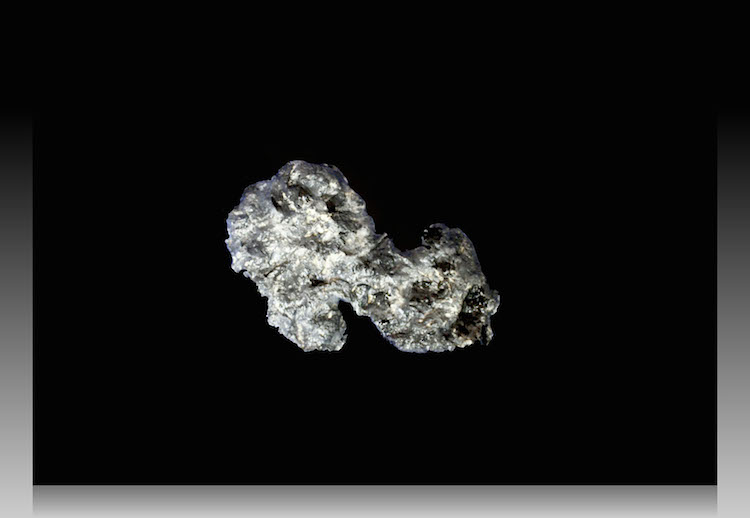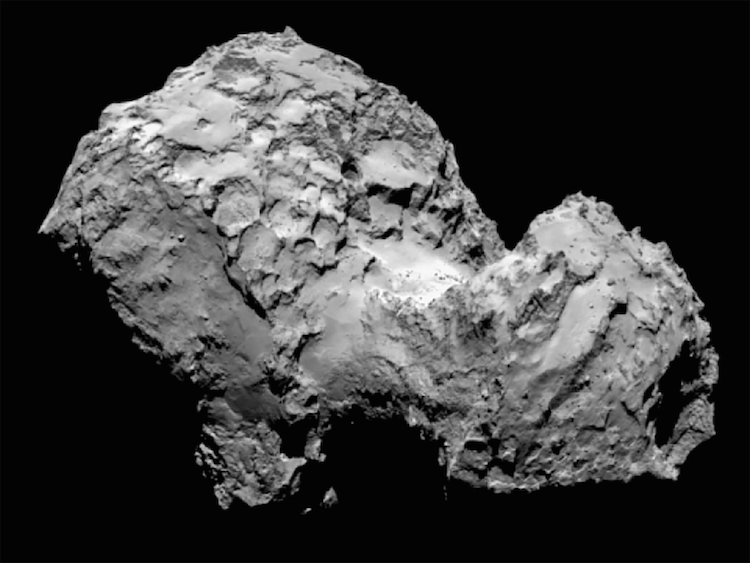Create a Handmade 3D Clay Sculpture of Asteroid 67P by Kathleen Horner
- Published: Wednesday, August 06 2014 20:44

Handmade 3D clay sculpture of comet 67P on a sheet of black paper
After a 10 year journey, Europe's Rosetta space probe has reached it destination to Comet 67P in deep space. It was discovered by two Ukranians, Klim Ivanovych Churyumov and Svetlana Ivanovna Gerasimenko. In November this year plans are to drop a lander onto the surface of the comet. The probe and lander are named after two ancient Egyptian inscribed stones, Rosetta (Probe) and Philae (Lander). Intense study of the comet utilizing the efforts of the Rosetta mission will yield further information on our understanding of the creation of stars and planets and how solar systems are formed. The Rosetta Mission is a very exciting and historical moment in the history of astronomical science and I can't wait to see what happens next come November!
Ten Things to Know About Comets
(Article courtesy of NASA)
Comets are cosmic snowballs of frozen gases, rock and dust roughly the size of a small town. When a comet's orbit brings it close to the sun, it heats up and spews dust and gases into a giant glowing head larger than most planets. The dust and gases form a tail that stretches away from the sun for millions of kilometers.
10 Need-to-Know Things About Comets:
If the sun were as tall as a typical front door, Earth would be the size of a nickel, dwarf planet Pluto would be the size of a head of a pin and the largest Kuiper Belt comet (about 100 km across, which is about one twentieth the size of Pluto) would only be about the size of a grain of dust.
1. Short-period comets (comets that orbit the sun in less than 200 years) reside in the icy region known as the Kuiper Belt beyond the orbit of Neptune from about 30 to 55 AU.
2. Long-period comets (comets with long, unpredictable orbits) originate in the far-off reaches of the Oort Cloud, which is five thousand to 100 thousand AUs from the sun.
3. Days on comets vary. One day on comet Halley varies between 2.2 to 7.4 Earth days (the time it takes for comet Halley to rotate or spin once). Comet Halley makes a complete orbit around the sun (a year in this comet's time) in 76 Earth years.
4. Comets are cosmic snowballs of frozen gases, rock and dust.
5. A comet warms up as it nears the sun and develops an atmosphere, or coma. The coma may be hundreds of thousands of kilometers in diameter.
6. Comets do not have moons.
7. Comets do not have rings.
8. More than 20 missions have explored comets from a variety of viewpoints.
9. Comets may not be able to support life themselves, but they may have brought water and organic compounds -- the building blocks of life -- through collisions with Earth and other bodies in our solar system.
10. Comet Halley makes an appearance in the Bayeux Tapestry from the year 1066, which chronicles the overthrow of King Harold by William the Conqueror at the Battle of Hastings.
How To Make a 3D Clay Asteroid Sculpture
As a tribute to celebrating this exciting mission, I created a handmade dough sculpture of the Comet 67P (see photo above). Teach your children about comets, the Rosetta Mission and what is happening out there in deep space. This is big stuff and a hands on educational sculpture session is the best way for them to learn (and you, too!). It's really easy! Here's some quick instructions.
Materials and ingredients for the dough recipe:
A sheet of black paper (any size)
A sheet of cardboard backing (same size as black paper)
Wax paper
Various items to create rough textures on surface of clay dough
Flour
Salt
Water
Flat dish
Black, White acrylic paint
Paint brush
Hot Glue, Craft Tacky Glue
Recipe for sculpture flour dough:
1 Cup Flour
1 Cup Salt
1/2 Cup Water
You can cut this recipe in half if you wish to sculpt one asteroid as I did. Mix all of the above recipe ingredients together until you have a clay like consistency. You can add a little flour to keep your hands from sticking to the dough. Knead the dough into a ball. Place on a plate with wax paper. Begin sculpting your asteroid following the photos that have been posted below this article or a from few printed photos that you have found of Comet 67P online. I used a dish scrubber brush and a large paint brush to create a stippled and rough texture on the surface of the sculpture. Work the surface with your fingertips for bumps, craters and recesses. Once you have finished sculpting the asteroid allow it to air dry out under the Sun for a day. You can also put it in the oven on very low heat to hurry along the drying process. Disclaimer: This is not the kind of dough that should be eaten so make sure that children understand it is only for sculpture play.
After your sculpture has hardened, place it onto a flat surface and begin the painting process. Mix the black and white paint until you achieve a gray hue. Begin painting your asteroid. Add a few blotches of black paint into some of the recesses on the surface for a bumpy, cratered effect. This is play time so just have fun with your imagination. No work of art has to look encyclopedic.
Place a sheet of black art paper or construction paper on your work table. Glue the sheet onto a cardboard backing. Squeeze some glue onto the back of the dried painted sculpture and press onto the black sheet. Allow to dry. Looks great hanging up on the wall!

Rosetta Probe's Course (credit ESA)

Comet 67P (Credit NASA/ESA)








Comments